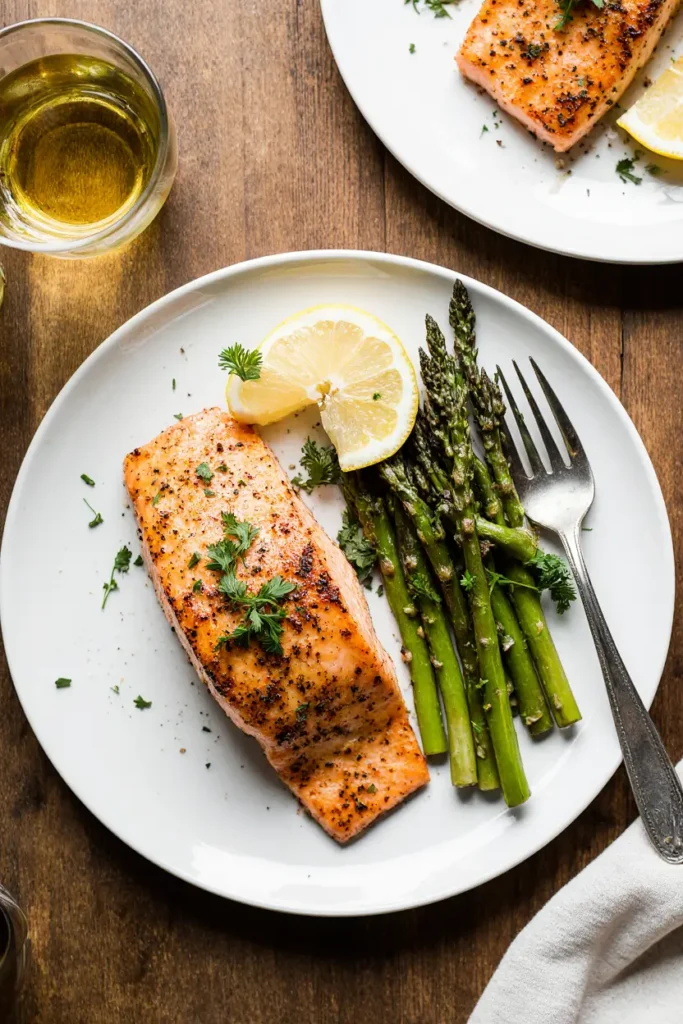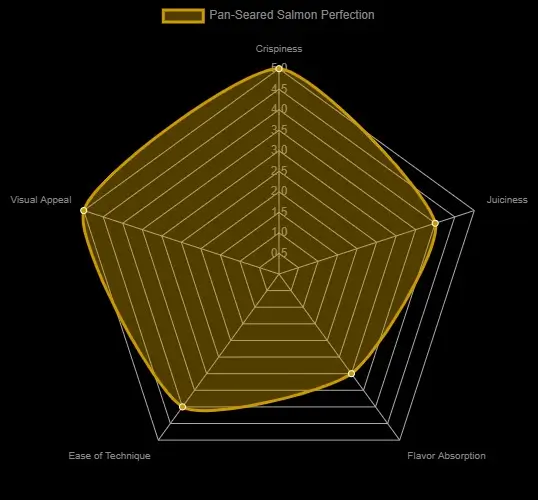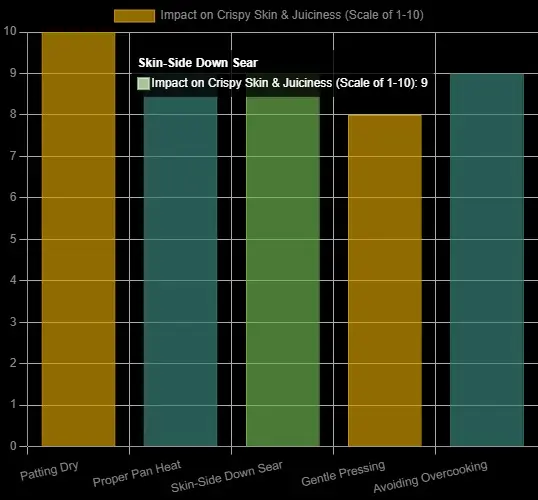
Master the art of stovetop salmon for a restaurant-quality meal in minutes.
Table of Contents
- 1.Essential Ingredients for a Flavorful Foundation
- 2.Step-by-Step Mastery: Achieving Crispy Skin and a Juicy Interior
- 3.The Final Touch: Serving Your Culinary Masterpiece
- 4.Understanding Salmon Cooking Dynamics
- 5.The Critical Role of Preparation Steps
- 6.A Mindmap for Pan-Seared Salmon Success
- 7.A Quick Guide to Pan-Seared Salmon
- 8.Visualizing the Perfect Pan-Seared Salmon
- 9.Frequently Asked Questions About Pan-Seared Salmon
- 10.Conclusion: Master Your Pan-Seared Salmon
- 11.Recommended Further Exploration
- 12.Referenced Search Results
- Crispy Skin is Key: The foundation of great pan-seared salmon lies in achieving a perfectly golden and crisp skin, which also locks in moisture.
- Simple, Yet Strategic Steps: From patting dry the fillets to choosing the right pan and cooking undisturbed, each step is designed for optimal results.
- Accessible for Home Cooks: This recipe transforms a seemingly complex dish into an easy, weeknight-friendly meal with minimal effort and common ingredients.
Stovetop salmon is a weeknight wonder, offering a quick and elegant meal that’s surprisingly simple to master. With just a few key techniques, you can achieve restaurant-quality results right in your own kitchen, boasting that coveted crispy skin and a wonderfully moist, flaky interior. This pan-seared salmon recipe is designed for home cooks, providing clear, actionable steps to ensure success every time.
Essential Ingredients for a Flavorful Foundation
Crafting delicious pan-seared salmon begins with a handful of fresh, high-quality ingredients. The beauty of this dish lies in its simplicity, allowing the natural flavors of the salmon to shine through.
The Core Components
- Salmon Fillets: Opt for skin-on fillets, ideally about 6-8 ounces each. The skin is crucial for achieving that desirable crispy texture and helps protect the flesh from overcooking.
- Olive Oil: A good quality olive oil is essential for searing and ensuring the salmon doesn’t stick while adding a subtle richness.
- Salt & Black Pepper: These fundamental seasonings enhance the salmon’s natural taste. Don’t be shy; generous seasoning is key to a flavorful exterior.
- Garlic: Freshly crushed or minced garlic infuses the oil with aromatic notes, adding depth to the final dish.
- Lemon: Fresh lemon wedges for serving are non-negotiable. A squeeze of lemon juice brightens the flavor and cuts through the richness of the fish.
Here’s a visual representation of the fresh ingredients, ready to be transformed into a culinary delight.
Fresh raw ingredients: salmon fillets, olive oil, salt, pepper, garlic, and lemon arranged on a cutting board.
Step-by-Step Mastery: Achieving Crispy Skin and a Juicy Interior
The journey to perfect pan-seared salmon is all about technique. Follow these steps meticulously to guarantee a restaurant-quality result in your own kitchen.
Preparation and Searing Fundamentals
Preparing the Salmon for Success
The single most important step for crispy skin is moisture removal. Pat the salmon fillets thoroughly dry with paper towels. Any surface moisture will steam the skin instead of searing it, preventing crispiness. Once dry, season both sides generously with salt and black pepper. Some recipes suggest adding minced garlic directly to the salmon at this stage for an extra flavor boost, while others prefer infusing the oil.
Heating the Pan to Perfection
Choose a heavy-bottomed skillet, such as cast iron or stainless steel, as it retains heat more consistently. Place the pan over medium-high heat and add the olive oil. If using crushed garlic for oil infusion, add it now. Wait for the oil to shimmer (about 1-2 minutes) before adding the salmon. This indicates it’s hot enough for an immediate sear, which is crucial for preventing sticking and achieving that golden crust.
The Art of Skin-Side Down Searing
Carefully lay the salmon fillets, skin-side down, into the hot skillet. Do not overcrowd the pan; if necessary, cook in batches to maintain the pan’s temperature and ensure proper searing. Immediately after placing the salmon, gently press down on each fillet with a spatula for the first 10-30 seconds. This ensures even contact between the skin and the hot pan, preventing the edges from curling up and promoting uniform crispiness. Cook undisturbed for about 4-7 minutes. You’ll notice the skin turning golden brown and crisp, and the color of the salmon flesh will begin to change, moving up the sides of the fillet.
Observe the magic happening in the pan as the skin transforms into a golden, crispy delight.
Salmon fillets sizzling skin side down in a hot pan.
Flipping and Finishing for Doneness
Once the skin is perfectly crispy and golden, carefully flip the salmon fillets using a spatula. If you chose to add minced garlic to the pan, now is the time to do so, allowing it to cook for another 1-2 minutes until fragrant. Continue cooking on the second side for an additional 2-5 minutes, depending on the thickness of your fillets and your desired level of doneness. For medium doneness, the internal temperature should reach 125-130°F (52-54°C). The flesh should be opaque and flake easily with a fork, but still appear juicy.
The Final Touch: Serving Your Culinary Masterpiece
Once cooked, remove the salmon from the pan and let it rest for about a minute. This allows the juices to redistribute, ensuring a tender and moist interior. Before serving, squeeze fresh lemon juice over the salmon. The bright acidity of the lemon perfectly complements the rich flavor of the fish and the crispy skin. Serve immediately with your favorite sides, such as roasted vegetables, a simple green salad, or rice, for a complete and satisfying meal.
Plated salmon with crispy skin, garnished with lemon, alongside simple sides like greens or rice on a dining table.
Understanding Salmon Cooking Dynamics
To truly master pan-seared salmon, it’s helpful to understand the interplay of factors that contribute to its perfect execution. The chart below illustrates key attributes and how various aspects of the cooking process influence them.

This radar chart provides an analytical view of pan-seared salmon’s key attributes. It shows that achieving high scores in crispiness, juiciness, and visual appeal is highly attainable with the right technique. Flavor absorption, while good due to seasoning and garlic, might be slightly less intense than, say, a marinade, but its simplicity makes it highly appealing. The ease of technique also scores high, making this method accessible for most home cooks.
The Critical Role of Preparation Steps
Each step in preparing pan-seared salmon contributes to the final outcome. The following bar chart highlights the impact of specific preparation steps on achieving the desired crispy skin and juicy interior.

This bar chart illustrates the significant impact of each crucial step on the overall success of pan-seared salmon. Patting the salmon dry stands out as the single most critical factor for achieving crispy skin, followed closely by proper pan heat and the initial skin-side down sear. Gentle pressing prevents curling, ensuring even contact, while avoiding overcooking is paramount for retaining the salmon’s natural juiciness. Each step, when executed correctly, contributes powerfully to the desired outcome.
A Mindmap for Pan-Seared Salmon Success
Visualizing the interconnected steps and considerations for pan-seared salmon can help solidify your understanding and ensure a flawless cooking experience. This mindmap outlines the core elements from preparation to serving.Pan-Seared
Salmon SuccessPreparationPat”Fillets”DrySeasoning SalmonGather IngredientsCooking ProcessChoose”Right”PanHeat Oil”Properly”Sear”Skin-Side”¶ß DownGentle”Pressing”Monitor”Cook”TimeFlip & FinishFlavor”Enhancement"Garlic”Infusion”Lemon”Zest”Layering”Seasoning”¶ßServing”Tips”Serve”Immediately"Complementary”Sides”Brief”Rest”PeriodTroubleshootingNo”Crispy”SkinOvercooked/”Dryfl°quot; SalmonSticking”to” Pan
This mindmap serves as a comprehensive guide, breaking down the pan-seared salmon recipe into manageable, interconnected concepts. It emphasizes the critical steps from preparing the salmon to mastering the searing process, ensuring perfect crispy skin. It also highlights flavor enhancement techniques and offers valuable serving tips, while also touching upon common troubleshooting points to help you achieve consistent success.
A Quick Guide to Pan-Seared Salmon
For a concise overview, the table below summarizes the key aspects of cooking pan-seared salmon, from preparation to serving, ensuring you hit all the crucial notes for a delicious result.
| Category | Key Action | Why It Matters |
|---|---|---|
| Preparation | Pat fillets thoroughly dry with paper towels. Season generously with salt and pepper. | Removes moisture for crispy skin; ensures flavor penetrates the fish. |
| Pan Setup | Use a heavy-bottomed skillet (cast iron/stainless steel). Heat olive oil over medium-high until shimmering. | Ensures even heat distribution for consistent searing; prevents sticking and promotes crispiness. |
| Initial Sear | Place salmon skin-side down. Press gently for 10-30 seconds. Cook undisturbed 4-7 minutes. | Maximizes skin contact with heat for uniform crisping; allows skin to develop without disturbance. |
| Finishing Cook | Flip, add garlic (if desired). Cook 2-5 minutes until opaque and flaky. | Ensures interior cooks evenly; garlic adds aromatic depth. |
| Serving | Rest for 1 minute. Squeeze fresh lemon juice. Serve immediately. | Allows juices to redistribute for moistness; lemon brightens and complements the fish. |
Visualizing the Perfect Pan-Seared Salmon
To further enhance your understanding and success with pan-seared salmon, here’s a highly relevant video demonstrating the techniques discussed. This video from “Epicurious” provides a professional chef’s perspective on achieving restaurant-quality results, focusing on tender, flaky flesh with perfectly crisp skin.
This video by Epicurious showcases a professional chef’s method for pan-searing salmon, emphasizing techniques for achieving both crispy skin and a tender, juicy interior. It’s an excellent visual aid that complements the written instructions, demonstrating critical steps like pressing the salmon down and judging doneness.
Frequently Asked Questions About Pan-Seared Salmon
What kind of pan is best for pan-searing salmon?
How do I prevent salmon skin from sticking to the pan?
How can I tell if my salmon is cooked through?
Can I cook salmon without the skin?
Conclusion: Master Your Pan-Seared Salmon
Achieving perfectly pan-seared salmon with golden crispy skin and a wonderfully juicy interior is a highly rewarding culinary skill that is surprisingly simple to master. By focusing on key techniques such as thoroughly drying the fillets, using a properly heated pan, initiating the sear skin-side down, and understanding doneness, you can consistently produce restaurant-quality results in your home kitchen. This dish is not only quick and healthy but also elegant, making it an ideal choice for both busy weeknights and special occasions. Embrace these straightforward steps, and you’ll soon enjoy the delightful experience of crafting delicious, flaky salmon every time.
Leave a Review
I love hearing from you! Submit your question or recipe review here. Your email address will not be published. Required fields are marked *
There are no reviews yet. Be the first one to write one.
